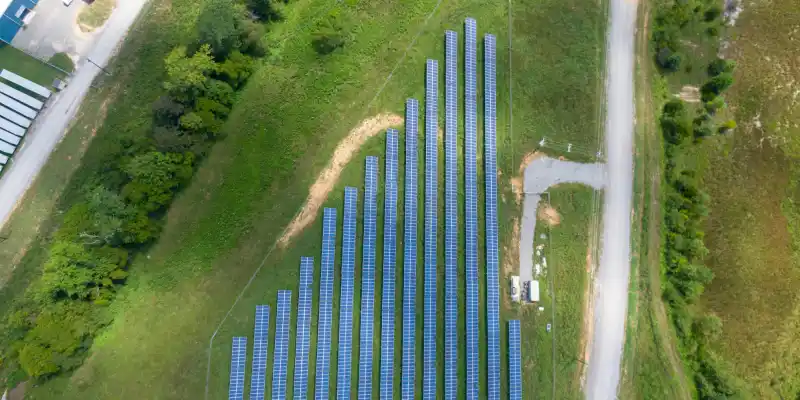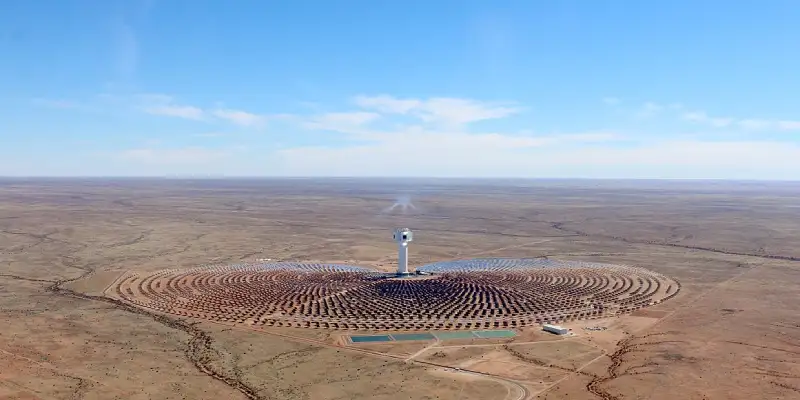A guide to solar energy
Solar energy simply involves converting solar radiation into valuable energy forms for human use, primarily electricity and heat.
In this guide, we offer a concise overview of the various types of solar energy available– and we’ll explore how different countries, including the UK, are advancing in this domain.
Let’s dive in.
Contents
- There are two types of solar energy
- Top 20 countries by solar power
- Top 10 countries by solar thermal
- Solar Energy in the UK
- FAQs
There are two types of solar energy
Solar energy is a form of renewable energy that harnesses solar radiation to produce electricity or heat for human consumption. It’s championed as green and low-carbon energy, given its zero operational carbon emissions throughout its lifecycle.
Solar electricity (power)


Electricity can be generated from the sun in two ways:
- Solar photovoltaic panels (PV): Sunlight stimulates an electric current in a cell through the photovoltaic effect.
- Concentrated Solar Power (CSP): Arrays of mirrors focus sunlight onto a single point, superheating it. This heat then drives a steam generator.
💡 Presently, the lion’s share of global solar electricity stems from solar PV rather than CSP, because PV technology has become significantly more affordable and efficient over recent decades. Its modular nature allows for diverse applications, from powering a quaint cottage to constituting vast “solar farms”, while CSP requires scale to concentrate significant amounts of sunlight.
💡 1,300 TWh of solar power was consumed globally in 2022. While seemingly substantial, it only represents 2.7% of total global power consumption!
Extended reading:
- Will perovskite PV cells spark a solar revolution?
- Is floating solar PV truly revolutionary?
- Agrivoltaic PV farms: Everything you need to know
- Portable solar PV power
Solar heat


Solar heat generation is fundamentally about exposing thermally conductive materials to sunlight. This is typically achieved through:
- Concentrated Solar Power (CSP): As with electricity generation, arrays of mirrors focus sunlight onto a single point to superheat it. This heat can then be stored in molten salt.
- Solar Thermal Collectors: The sun’s rays heat a conductive material, which subsequently heats a fluid, often water. This heated water can then be utilised for space heating, domestic hot water, or industrial and agricultural processes.
💡 Solar Thermal Collectors are effective even at high latitudes because the heat is transmitted via electromagnetic radiation, irrespective of outdoor temperatures.
Extended reading:
- Australian greenhouses watered with seawater desalinated using solar heat
- Solaris Prism: A scalable solar-powered water heating unit
Top 20 countries by solar power
To have a global overview of where solar energy is used the most, here’s a list of the top 20 countries when it comes to the generation of electricity from solar radiation, be it solar PV or CSP.
| Country | Solar power consumed in 2022 (TWh) | TWh per milllion people | |
|---|---|---|---|
| 1 | China | 420 TWh | 0.29 |
| 2 | United States | 204 TWh | 0.61 |
| 3 | Japan | 99 TWh | 0.78 |
| 4 | India | 95 TWh | 0.07 |
| 5 | Germany | 59 TWh | 0.71 |
| 6 | Australia | 33 TWh | 1.27 |
| 7 | Spain | 32 TWh | 0.68 |
| 8 | South Korea | 29 TWh | 0.56 |
| 9 | Italy | 27 TWh | 0.45 |
| 10 | Brazil | 26 TWh | 0.12 |
| 11 | Vietnam | 26 Twh | 0.27 |
| 12 | France | 20 TWh | 0.29 |
| 13 | Netherlands | 17 TWh | 0.94 |
| 14 | Turkey | 16 TWh | 0.19 |
| 15 | Chile | 15 TWh | 0.77 |
| 16 | UK | 14 TWh | 0.21 |
| 17 | Mexico | 13 TWh | 0.10 |
| 18 | Taiwan | 11 TWh | 0.46 |
| 19 | Poland | 8 TWh | 0.21 |
| 20 | Belgium | 7 TWh | 0.58 |
Source: Ourworldindata.org; globalsolaratlas.info
💡 The UK is the 16th largest consumer of its home-grown solar power despite being renowned for its lack of sunshine. This may seem impressive at first glance, but the sobering fact is that the Netherlands produces significantly more power with a very similar solar resource despite having only one-sixth of the population.
Extended reading:
Top 10 countries by solar thermal
Interestingly, the top 10 for solar electricity and solar thermal vary greatly, highlighting the influence of public perception and political will in deciding how to generate energy.
Both technologies are effective across almost all latitudes, and there’s a universal need for hot water. This will quickly become evident from the list:
| Country | Total Capacity (MW) | Capacity per person (MW per million people) | |
|---|---|---|---|
| 1 | China | 381,538 | 270 |
| 2 | Turkey | 18,153 | 213 |
| 3 | United States | 15,556 | 48 |
| 4 | Brazil | 14,339 | 67 |
| 5 | Germany | 13,722 | 164 |
| 6 | India | 12,816 | 9 |
| 7 | Australia | 6,681 | 256 |
| 8 | Mexico | 3,859 | 35 |
| 9 | Greece | 3,623 | 362 |
| 10 | Italy | 3,585 | 60 |
💡 Greece is clearly an unsung hero of solar thermal, boasting a large capacity per capita while making it into the top 10. This offers another national accolade, alongside its rich culture, mythology, scenic islands.
💡 China’s reputation as a heavy polluter is often misplaced. Despite its high emissions, China leads the way in almost all forms of renewable and low-carbon energy. In this context, China tops the charts in both solar electricity and solar thermal capacity.
💡 Despite having one of the world’s poorest solar resource, Germany consistently ranks among the top nations for both solar thermal and solar PV capacity.
Solar Energy in the UK
The UK is home to numerous solar farms that provide renewable electricity to the national grid during daylight hours. Most of these are situated in the relatively sunnier southern part of the country.
Approximately 4% of the UK electricity comes from solar power (including residential and commercial solar power installations). This proportion is on the rise, spurred by the falling cost of solar panels and the rising cost of grid electricity due to the recent energy crisis.
This situation has precipitated a significant increase in the installation of solar panels and solar thermal collectors in the UK, as trust in the government’s ability to keep electricity prices at a manageable level has eroded considerably.
And typically accompanying his surge in small-scale solar power are three burgeoning phenomena: solar PV batteries, distributed electricity grids, and the little-discussed Utilities Death Spiral.
In essence, as homes and businesses move towards complete energy independence – and even profitability through electricity arbitrage– through integrated solar and battery systems, a distributed virtual power plant emerges. This system is not only more cost-effective but also more resilient than the power stations operated by utilities, leading to their potential decline. Note that utilities bear substantial costs in maintaining their extensive infrastructure.
We digress, solar energy is certainly the rising star of renewable energy. We hope that this introductory guide has offered a comprehensive insight into the essence of “solar energy” in the broader context of human energy consumption.
Extended reading:
- Data Insights: Power generation in the UK
- A guide to commercial solar panels in the UK
- A guide to solar PV batteries
- Are distributed electricity grids the future?
- Should we be worried about a utilities death spiral?
FAQs
In this section, we address some of the frequently asked questions that arise when people first delve into the intricate world of solar energy.
Why is solar energy renewable?
Solar energy is classed as renewable energy because it’s an inexhaustible energy source.
Energy is deemed “sustainable” if it is replenishing at the same rate the human population uses it. Solar energy meets this criterion because every day, regardless of how much we harness for electricity generation, the sun emits a consistent amount of energy towards the Earth.
In contrast, fossil and nuclear fuels have formed over thousands of years, meaning the replenishment rate is significantly slower than the rate humans use it, qualifying it as non-renewable.
If fossil fuels were renewing themselves at replenishable rates at a human time scale, they’d also be renewable– it’s actually not a matter of emissions.
Is solar energy “green”?
Solar energy is classed as “Green energy”.
Green energy is the production of electricity from renewable sources that do not emit greenhouse gases in electricity generation. Solar energy uses the inexhaustible supply of sunlight to the earth in a process that does not directly produce greenhouse gases.
Read our in-depth guide on green energy.
What are the benefits of using solar energy for businesses?
Solar energy is a popular option of renewable energy for businesses; here’s why:
- It’s cost-effective. The initial cost of installing solar panels is reasonable, and the subsequent reduction in electricity bills ensures a quick return on investment.
- Reduces your overall energy bills. As highlighted above, the competitive cost of solar panel installation means businesses can rapidly recoup their initial expenses. Electricity consumption is a major overhead for many companies, so they can substantially lower their business electricity rates by generating their own solar energy.
- Promotes sustainability. Using solar panels for business electricity serves as a tangible testament to a company’s commitment to green initiatives and environmental sustainability.
Compare commercial solar panels today with AquaSwitch.
What are the environmental benefits of commercial solar power?
For many businesses, their daily environmental impact is important.
Opting for solar energy as a renewable energy source diminishes the reliance on energy generated from finite resources, such as fossil fuels. This decision carries profound environmental benefits, including:
- Reducing greenhouse gas emissions: Solar panels and thermal collectors generate electricity and heat without emitting carbon dioxide or other harmful pollutants, thus aiding in the mitigation of climate change.
- Increased efficiency: By generating electricity on-site, transmission losses associated with electricity distribution are significantly minimised.
- Decreased dependency on fossil fuels: The fossil fuel supply chain is rife with environmental hazards, from spills to emissions during extraction and transportation. Though solar panels also have an environmental footprint, it is markedly smaller compared to the impact of fossil fuels.
Solar energy vs Fossil fuels – what’s the difference?
Solar energy is a renewable energy source powered by radiant heat and light produced by the sun, while the energy released during the combustion of non-renewable fossil fuels (usually coal, oil or natural gas) is associated with harmful gasses that are released Earth’s atmosphere.
There’s a massive contrast in the environmental impact of the two forms of energy. Here are the pros and cons of the two:
Solar energy
Pros:
- Produces significantly fewer carbon emissions.
- Offers predictable energy prices tied to sunlight.
- Requires minimal operational costs since the sun provides free energy.
- Scalability: From a single panel for phone charging to thousands for a power station.
- Safer, given that the fossil fuel supply chain has high mortality rates.
Cons:
- Less energy dense: Larger land areas are needed to produce equivalent energy.
- Requires additional components like solar batteries, charge controllers, and alternators to achieve “baseload” power.
Fossil fuel
Pros:
- Established infrastructure and expertise.
- Provides employment to millions globally.
- Production is weather-independent.
- Offers the convenience of maintaining existing systems.
Cons:
- Major contributor to carbon emissions and subsequent climate change.
- Emission-induced air pollution adversely affects human health.
- Disasters related to fossil fuels (e.g., oil spills, oil fires, coal mining mishaps, gas explosions) tend to be far more catastrophic than those linked to renewable sources.
- Resources are finite, risking depletion.
- As supplies dwindle, economic challenges may arise.
What products can I compare at AquaSwitch?
Use our business energy comparison services to compare the latest green energy tariffs offered by verified business energy suppliers. Also, use our business water comparison report to compare the latest green water tariffs.
If you’re looking to compare business gas prices or business electricity prices, click one of the links below:

